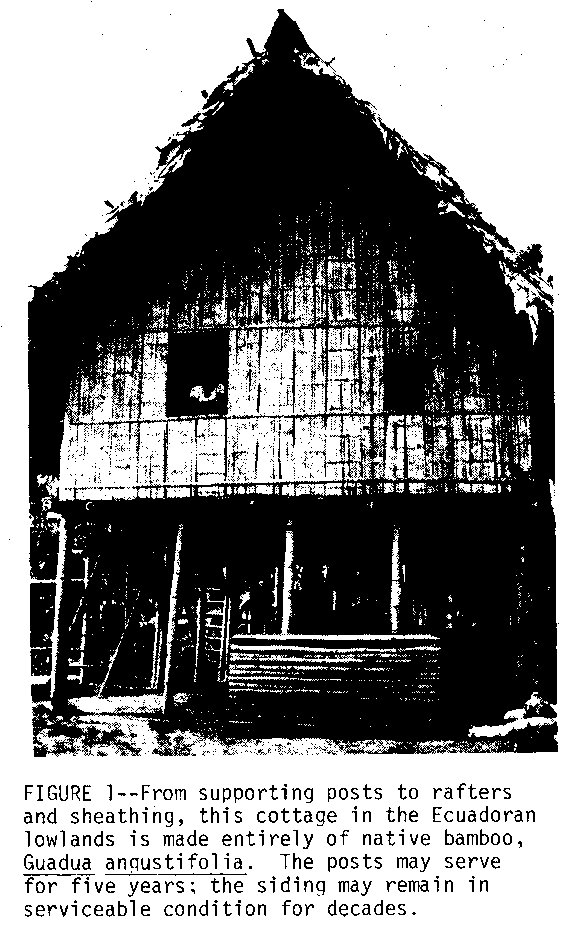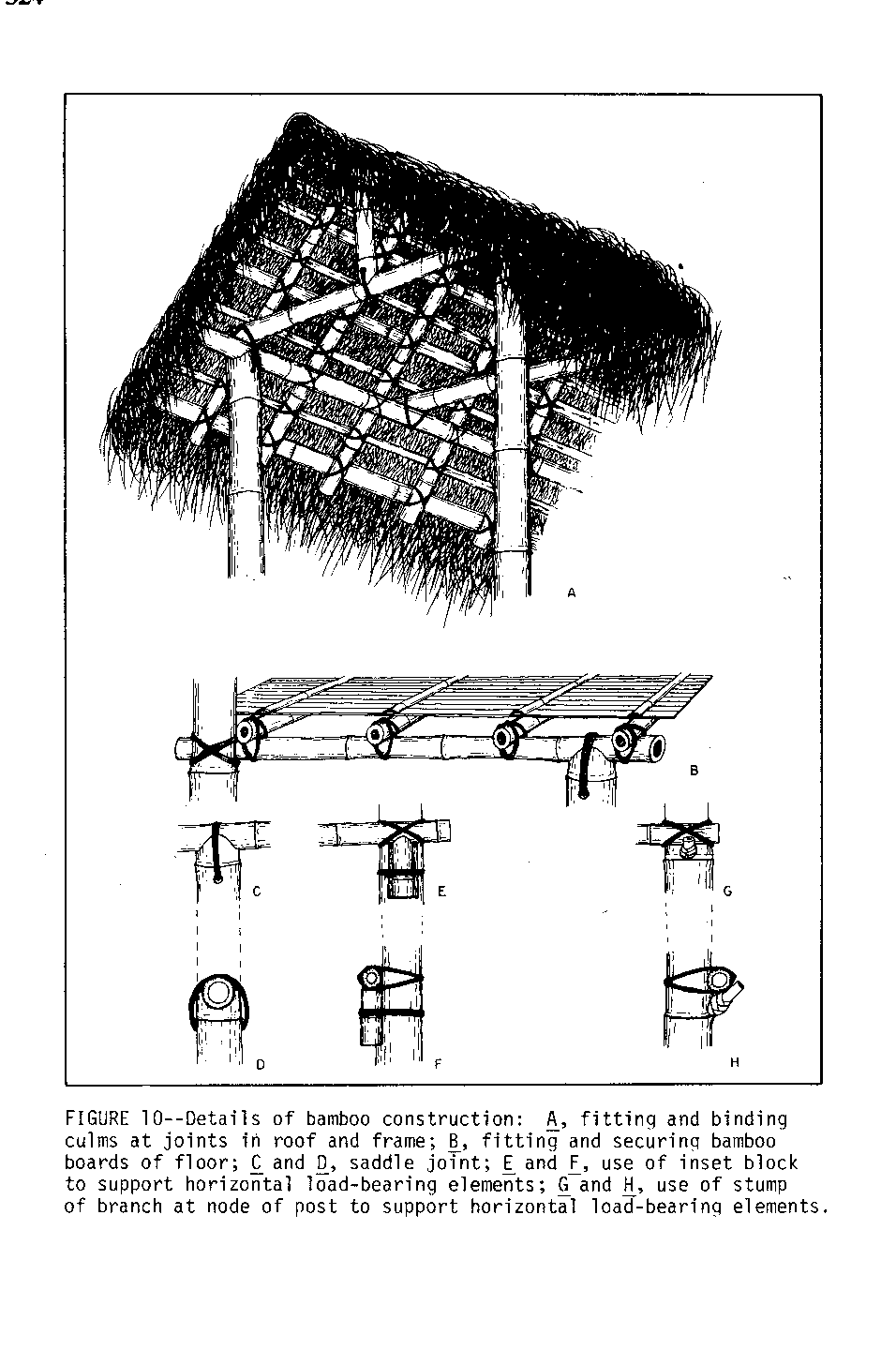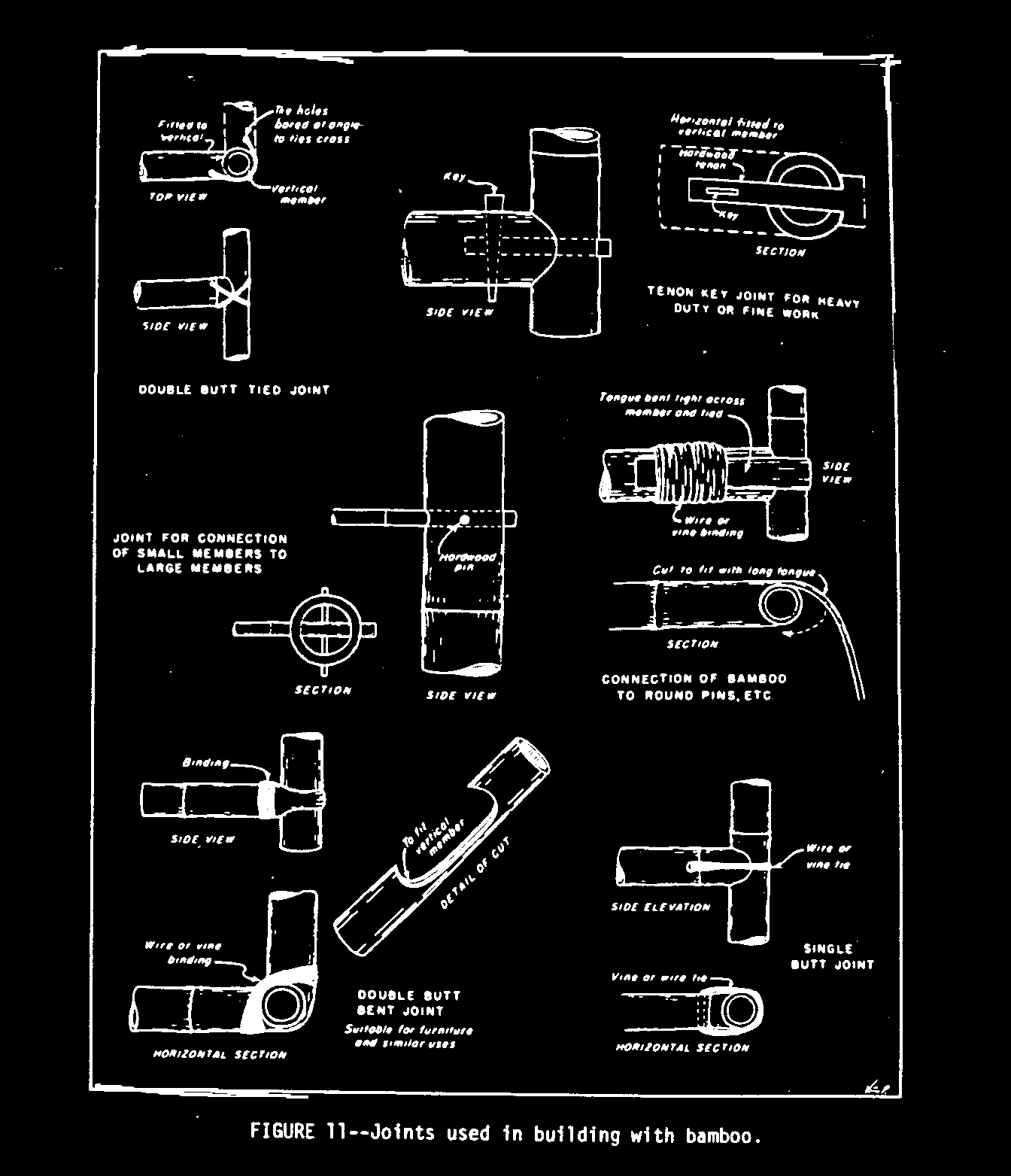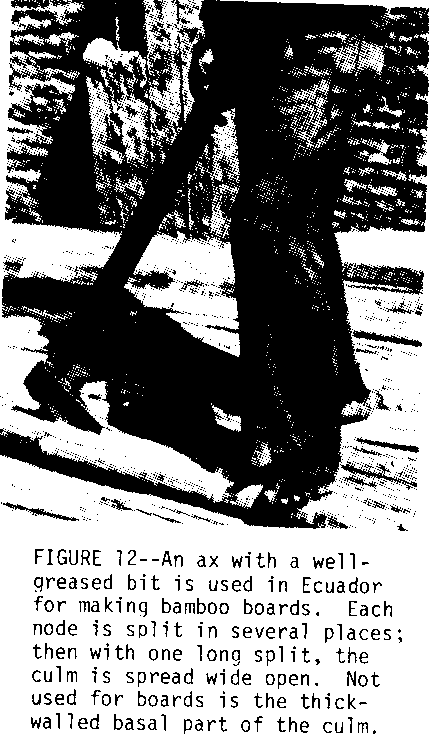Bamboo is one of the oldest materials people have used to increase their comfort and well-being. In today's world of plastics and steel, besides continuing to make its traditional contributions, bamboo is growing in importance. Outstanding varieties of bamboo from throughout the world are being tested to find out how they can contribute to local economies.
As the best species are identified and disseminated, their use will help to improve the lives of many. With a few plants of superior bamboos in the backyard, a family will have at hand the wherewithal to fence the garden, build a pigpen or chicken coop, or add a room to the house. The family will also be able to increase its daily income by making baskets or other specialties for sale or exchange.
Bamboos are prominent elements in the natural vegetation of many parts of the tropical, subtropical and mild temperate regions of the world, from sea level to altitudes or more than 13,000 feet (4000m). People have widened the distribution of many species of bamboo, but some of the more valuable species have not been distributed as much as they could be.
Bamboo can be prepared for use in construction with simple tools. Once prepared, bamboo can be used extensively in the construction of houses: <see figure 1> in making foundations,

frames, floors, walls, partitions, ceilings, doors, windows, roofs, pipes, and troughs. For further detail, see Bamboo as a Building Material, by F. A. McClure.
The entries that follow explain:
- Splitting and preserving bamboo
- Bamboo joints
- Making bamboo board
- Bamboo walls, partitions, and ceilings
PREPARING BAMBOO
Splitting Bamboo
To prepare bamboo for use in construction, the culms (stems) must be carefully split.
Tools and Materials
Iron or hardwood bars, 2.5cm (1") thick Ax Steel wedges Wooden posts Splitting knives (Figure 4)
Several devices can be used for splitting culms. When bamboo is split the edges of the bamboo strips can be razor-sharp; they should be handled carefully.
Splitting Small Culms
Small culms can be split to make withes (strips) for weaving and lashing:
- Use a splitting knife with a short handle and broad blade to make four cuts, at equal distances from each other, in the upper end of the culm (Figure 2).
- Split the culm the rest of the way by driving a hardwood cross along the cuts (Figure 3).
- Using a long-handled knife (see Figure 4), cut each strip in half (see Figure 5).

A strip of bamboo can be held on the blade to make it thicker and speed up the work.
- Use the same knife to split the soft, pithy inner strip from the hard outer strip (see Figure 6). The inner strip is usually discarded.
Splitting Heavy Culms
- Build a cross of iron or hardwood bars about 2.5cm (1") thick, and place it on firmly set posts about 10cm (4") thick and 90cm (3") high (see Figure 7).
- At the top end of the culm, use an ax to make two pairs of breaches at right angles to each other (see Figure 7).
- Hold the breaches open with steel wedges placed a short distance from the end of the culm, until the culm is on the cross as shown in Figure 7.
- Push and pull the culm until the cross splits the whole culm.
- To split the culms again after they are split into four strips, use a simple steel wedge mounted on a post or block of wood (see Figure 8).
- Paired wedges solidly mounted on a block or heavy bench can be used to split strips into three narrower strips (see Figure 9).
Bamboo Preservation
Most bamboos are subject to attack by rot fungi and wood-eating insects. Bamboos with higher moisture and starch content seem to be more prone to attack, and insect pests may be more of a problem in some seasons than others. So bamboo should be cut if possible in the bugs' "off-season." There are many methods for making bamboo more resistant to attack. A simple method that combines proper curing and the use of a pesticide (insecticide and/or fungicide) is described here.
If bamboo is to be used to hold food or water, the only treatment recommended is immersion of green bamboo in a borax-boric acid solution (see Bamboo Piping).
Tools and Materials
Machete and hacksaw for felling and trimming bamboo culms Pesticide-choice depends on the insect or fungus pests that are prevalent in your area. Consult your local extension agent or farmers in the neighborhood about the type and its use. Follow directions carefully. Talc-to mix with dry pesticide according to package instructions. If talc is not available, other dry dusty materials such as finely powdered dried clay is used. Dusting bag (made from cloth with an open weave)
Bamboo should not be cut before it is mature. This is usually the end of the third season. Freshly-cut bamboo culms should be dried for 4 to 8 weeks before being used in building.
A clump-curing process tested by the U.S. Department of Agriculture Federal Experiment Station in Puerto Rico helps to reduce attack by insects and rot fungi. The steps are:
- Cut the bamboo off at the base, but keep it upright in the clump.
- Dust the fresh-cut lower end of the culm at once by patting it with a dusting bag filled with the pesticide-talc mixture. An alternative method of dusting is to dip the ends of the culms into a tray containing the mixture.
- To keep the bamboo from being stained or rotted by fungi, raise each culm off the ground by putting a block of stone, brick, or wood under it. + Leave the culms in this position for 4 to 8 weeks, depending on whether the weather is dry or damp.
The culms should be as dry as possible before being placed near buildings, where wood eating insects usually are.
- When the culms have dried as much as conditions will permit, take them down and trim them. Dust all cut surfaces immediately with the pesticide-talc mixture.
- Finish the seasoning in a well-aired shelter where the culms are not exposed to rain and dew. Rain will stain the culms when they become dry.
This method will prevent damage by wood-eating insects while the culms are drying.
If the bamboo is to be stored for a long time, stacks and storage shelves should be sprayed every six months with the appropriate pesticide mixed in water or light oil. Local conditions may shorten or lengthen the time between sprayings.
In both storage and use, bamboo culms are best preserved when they are protected against rain in a well-ventilated place where they do not touch the ground.
BAMBOO JOINTS
A number of methods of joining bamboo for making implements or for construction are shown in Figures 10 and 11.

Bamboo Lashing material: cord or wire Machete, hacksaw, knife, drill, and other bamboo working tools
Bamboo is useful for heavy construction because it is strong for its weight. This is because it is hollow with the strongest fibers on the outside where they give the greatest strength and produce a hard attractive surface. Bamboo has solid diaphragms across each joint or node, which prevent buckling and allow the bamboo to bend considerably before breaking.
Any cut in the bamboo, such as a notch or mortise, weakens it; therefore, mortise and tenon joints should not be used with bamboo. However, notches or saddle-like cuts can be made at the upper ends of posts which hold cross pieces (see Figure 10, C an D).
Bamboo parts are usually lashed together because nails will split most culms. The withes (strips) for lashing are often split from bamboo and sometimes from rattan. When all local bamboo yields brittle withes, lashing must be done with bark, vines or galvanized iron wire.
In bending bamboo--for example, for the "Double Butt Bent Joint" in Figure 11-you

can help to keep the bamboo from splitting by boiling or steaming it and bending it while it is hot.
Local artisans often know the best species of bamboo and they have frequently worked out practical methods for making joints.
BAMBOO BOARDS
Bamboo culms can be split and flattened to form boards for use in sheathing, walls, or floors.
Tools and Materials
Machete Ax--lightweight, with a wedge-shaped head Spud--a long-handled shovel-like implement with a broad blade set at an angle to work parallel to the surface of the board. Large bamboo culms
Not all of the tools listed above are necessary, but they speed up the work when a large quantity is being produced.
+ Remove the thick-walled lower part of the culm. + Use an ax with a well-greased blade to split each node of the culm in several places (see Figure 12). This should be done carefully to avoid

injuring one's feet.
- Spread the culm wide open with one long split.
- Remove the pith at the joints with a machete, adz, or spud (see Figure 13).
- Store the boards as shown in Figure 14.
BAMBOO WALLS, PARTITIONS, AND CEILINGS
Bamboo buildings can be built to meet a variety of requirements for strength, light, ventilation, and protection against wind and rain. A few of the methods of building with bamboo are described here.
The parts of a building that are not usually made from bamboo are the foundation and the frame.
Both split and unsplit bamboo culms are used in building. They can be used either horizontally or vertically. Culms exposed to the weather, however, will last longer if they are vertical because they will dry better after rain.
Tools and Materials
Local bamboos Bamboo-working tools, such as machete, hacksaw, chisel, drill Lashing material: wire or cord Nails Barbed wire Plaster or stucco
Walls
A method commonly used in Ecuador for making walls is to lash wide bamboo strips or thin bamboo culms, horizontally and at close intervals, to both sides of hardwood or bamboo uprights. The spaces between the strips or culms are filled with mud alone or with mud and stones.
In Peru, flexible bamboo strips are woven together and then plastered on one or both sides with mud.
An attractive but weaker wall can be built by using bamboo boards, stretched laterally as they are attached, as a base for plaster or stucco. Barbed wire can be nailed to the surface to provide a better bond for the stucco. The exterior can be made very attractive by whitening it with lime or cement. <see figure 15>
Partitions
Partitions are usually much lighter and weaker than walls. Often they are no more than a matting woven from thin bamboo strips and held in place by a light framework of bamboo poles. Bamboo matting is often used to finish ceilings and both interior and exterior walls; bamboos with thin-walled, tough culms are usually used for this.
Ceilings
Ceilings can be built with small, unsplit culms placed close together or with a lattice of lath-like strips split from larger culms. There should be some space to let smoke from kitchen fires escape.
Source:
McClure, F.A. Bamboo as a Building Material. Washington, D.C.: Foreign Agricultural Service, U. S. Department of Agriculture, 1953; reprinted 1963 by Office of International Housing, Department of Housing and Urban Development.
Sources of information of bamboo are:
Forestry Division Joint Commission on Rural Reconstruction 37 Nan Hai Road Taipei, Taiwan
Forest Research Institute P.O. New Forest Dehru Dun, India
Tropical Development & Research Institute 56-62 Grays Inn Road London, WC 1 England
Federal Experiment Station in Puerto Rico U.S. Department of Agriculture Mayaguez, Puerto Rico